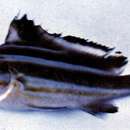en
names in breadcrumbs


Schooling is present in many species, but may become less common in older individuals.
(Lindeman & Toxey, 2002)
Oblong, compressed, perchlike fishes to 75 cm total length. Head profile strongly convex in most species.Mouth small to moderate, lips often thick;chin with 2 pores anteriorly and, in all but 1 genus, a median groove. Teeth conical, in a narrow band in each jaw, the outer series enlarged but no canines.No teeth on roof of mouth.Posterior margin of suborbital not exposed; preopercle with posterior margin slightly concave and serrated; opercle with 1 spine. Dorsal fin single, with 11 to 14 strong spines and generally 11 to 19 soft rays. Pectoral fins moderately long; pelvic fins below base of pectoral fins, with 1 spine
and 5 soft rays. Anal fin with 3 strong spines, the second often very prominent, and 6 to 13 soft rays; caudal fin emarginate to forked. Scales ctenoid (rough to touch), small or moderate, extending onto entire head (except front of snout, lips, and chin). Colour: highly variable, ranging from uniformly coloured to striped, banded, blotched and spotted. Adult stages of most species have distinctive colour patterns. Early juveniles (2 to 5 cm) of Haemulon, Anisotremus, and Orthopristis share a pattern of dark dorsolateral and midlateral stripes, and a caudal spot.The length of the upper eye stripe, coupled with other characters, is essential to separating the extremely similar early juvenile stages of Haemulon.The early juvenile pigment pattern can also be ephemerally displayed in adults of many species.
(Lindeman & Toxey , 2002)
Fishes of shallow, nearshore waters; nearly all from tropical and subtropical waters. Many species of Haemulon and Anisotremus inhabit coral reef or hardbottom areas and many forage nocturnally over nearby sand and grass flats. Juveniles typically occur in shallower water than adults and may show several ontogenetic habitat shifts during growth.
(Lindeman & Toxey, 2002)
Lutjanidae: canine teeth frequently present in jaws; no pores on chin; teeth present on roof of mouth; suborbital area scaleless; spines of dorsal and anal fins weaker.
Sciaenidae: anal fin with never more than two spines; lateral-line scales extending to posterior margin of caudal fin; often with rounded snout; barbels or canine-like teeth sometimes present; swimbladder usually large and complex (except in Menticirrhus where it is rudimentary, or absent). Gerreidae: anterior part of lower head profile concave;mouth strongly protrusible; interorbital region slightly concave.
Sparidae: suborbital area scaleless; no serrations on margin of preopercle; 2 pores not present beneath chin.
(Lindeman & Toxey, 2002)
The absence of documented spawning events suggests that reporduction typically occurs after sunset.
(Lindeman & Toxey, 2002)
Juvenile mortality from shrimp trawl bycatch is high in several species. Fishing gear includes traps, hook-and-line, seines,
and bottom trawls. FAO statistics from Area 31 report landings ranging from 11 335 to 18 081 t annually from
1995 to 1999.
(Lindeman & Toxey, 2002)
Most species feed on a variety of benthic invertebrates, particularly crustaceans and polychaetes. Several smaller species may primarily feed on plankton, while several larger species feed in part on echinoids.
(Lindeman & Toxey, 2002)
Several grunts are considered good foodfish and are actively fished for. Due to their abundance, many species are also obtained opportunistically and exploited commercially or recreationally.
(Lindeman & Toxey, 2002)
Haemulidae is a family of fishes in the order Perciformes known commonly as grunts. It is made up of the two subfamilies Haemulinae (grunters) and Plectorhynchinae (sweetlips), which in turn contain about 133 species in 19 genera.[4] These fish are found in tropical fresh, brackish, and salt waters around the world. They are bottom-feeding predators, and named for the ability of Haemulinae to produce sound by grinding their teeth.[5] They also engage in mutualistic relationship with cleaner gobies of genus Elacatinus, allowing them to feed on ectoparasites on their bodies.[6]

The family Haemulidae is divided into the following subfamilies and genera:[3][7]
Haemulidae is a family of fishes in the order Perciformes known commonly as grunts. It is made up of the two subfamilies Haemulinae (grunters) and Plectorhynchinae (sweetlips), which in turn contain about 133 species in 19 genera. These fish are found in tropical fresh, brackish, and salt waters around the world. They are bottom-feeding predators, and named for the ability of Haemulinae to produce sound by grinding their teeth. They also engage in mutualistic relationship with cleaner gobies of genus Elacatinus, allowing them to feed on ectoparasites on their bodies.